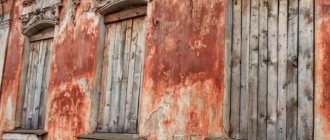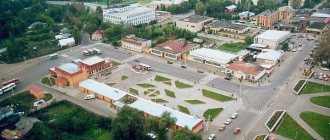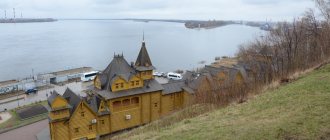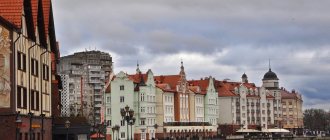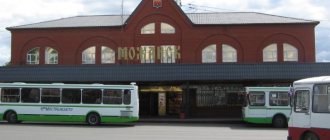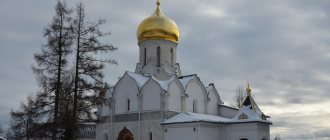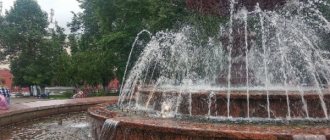Omsk, Russia
For a very long time I have been planning to write about the city in which I live and to which I invariably return from all my travels. And now, finally, a truly worthy reason has appeared for this - in 2016 Omsk turned 300 years old. For this occasion, the city was transformed, and now there is something to see and do in Omsk. I offer you a route that can be completed in one day or divided into several, and which includes all the main Omsk attractions.
River Station
I suggest starting a tour of the city from an iconic place - the monument to the founders of the city or, in simple terms, the “Omsk ball”. Our ball became famous throughout the country when, during a hurricane, he tried to leave the place intended for him. For some time he even had to be propped up with a tractor, and this topic was discussed on the Internet for a very long time.
Here, a few steps behind the River Station building at the confluence of the Irtysh and Om, there is a cannon, near which “getting married” people love to take pictures.
We walk further and next to the central registry office we see the Batyushkin House, which is also the apartment of Admiral Kolchak during the difficult period for our country of 1918-1919. Now there is a center for studying the history of the Civil War, but neither I myself nor anyone I know has been there.
Batyushkin's house
We go straight to the Central Beach - a resting place for fearless Omsk residents, who are not embarrassed by the doctors’ warnings about the state of the water, and even the sand itself.
Omsk central beach - looks better against the backdrop of sunset than during daylight hours
Just behind the beach is the famous Senkevich restaurant with a view of two Omsk bridges, the Irtysh and the fearless Omsk people. The price level here is above average, but the cuisine is praised. An iron tree was installed in front of Sienkiewicz, on which the newlyweds hang their locks.
On the left is the Senkevich restaurant
The same tree with locks and one of the many Omsk cyclists
Omsk in 2 days: “Bird Harbor”, saber master class and walks around the city
More than a million people live in Omsk. It is the eighth city in Russia in terms of population. It was founded by the Cossack Ivan Dmitrievich Buchholz in 1716. His squad went to Siberia in search of gold. Buchholz, having reached the confluence of two rivers - the Om and Irtysh, decided to try his luck here. The prospectors did not find any gold, but they decided to leave the village where the workers and peasants who came to settle lived. This is how the future cultural center of Siberia, the city of Omsk, was born. Over time, the settlement grew and turned into a small county town, where people began to be sent to hard labor. F.M. Dostoevsky (the house in which he lived still stands) and N.S. Gumilyov lived in exile here.
A powerful impetus to the growth of Omsk was given by the construction of the Trans-Siberian Railway, after which it received the status of the capital of a huge province.
Omsk is a city with a rich history and a difficult fate, and even if you only have a couple of days, you can have an interesting time here.
Coming to Omsk for the weekend will be interesting for residents of Tyumen, Barnaul, Tomsk, Novosibirsk and other nearby cities, the journey from which will not take much time.
The approximate travel budget for one person is from 4,200 rubles*.
- Return train tickets (from Barnaul) from 1,842 rubles*. Air traffic is established from Tomsk, Novosibirsk, Tyumen. You can fly from Moscow to Omsk every day. Prices start from 4,683 rubles* one way. The flight lasts on average 3 hours.
- 1 night in a hostel - from 350 rubles* or in a 3* hotel - from 1,770 rubles*;
- The average bill in a cafe is 400 rubles;
- Walks around the city, travel on public transport, souvenirs - 800 rubles.
Irtyshskaya embankment
Photo: Roofsoldier / Shutterstock.com
You can start exploring the city with a walk along the Irtysh embankment, which offers a beautiful view of one of the largest Siberian rivers. On the embankment there is a mansion of the merchant Batyushkov, where in 1919 an attempt was made on the life of the famous admiral Alexander Kolchak. Now there is the building of the Omsk registry office, a museum and a center for studying the history of the Civil War.
On the embankment, city residents love to exercise: there are running and cycling paths, and outdoor exercise equipment.
In the walking area there are sculptural compositions: a pair of deer, a metal “Tree of Love” on which couples and newlyweds hang heart-shaped locks, there are several viewing platforms, and stairs leading down to the water.
Omsk fortress
Photo: @darchich / Instagram.com
In 1717, settlers began building a fortress to protect the future city from invasions of nomads. On the territory of the complex, buildings from the 18th century have been preserved: the buildings of the barracks, the armory, the arsenal, the money storeroom and the Tobolsk Gate - the only of the fortress gates (initially there were 4 of them) that have survived to this day. The remaining gates have now been restored.
We recommend visiting the “Servant People of Siberia” excursion, during which you can see, touch and photograph reconstructed chain mail and helmets, find out what weapons and what clothes warriors of different classes wore to battle in the 17th and 18th centuries. At the end of the tour, take a look at a master class on saber, pike and cannon shooting.
Address: st. Partizanskaya, 5a Opening hours: Mon-Thu from 9:00 to 18:00, Fri from 9:00 to 17:00, Sat-Sun - day off** Tour cost: 120 rubles Website: omskkrepost.ru
Lyubinsky Prospekt
Photo: www.golos-omska.ru
Part of Lenin Street, passing through the historical part of the city, is popularly called “Lyubinsky Prospekt”. Once upon a time in these places there was a Lyubina Grove, which in 1851 Governor Gustav Gasfort ordered to be planted in honor of his wife Lyubochka (Lyubov Gasfort), who died of consumption at the age of 23. This place has become a favorite place for walks among the townspeople.
Instead of a grove, merchant shops were later built here and Lenin Street was laid out. Now it’s interesting to just walk along the avenue - the houses built at the beginning of the last century have recently been restored, some of them have been given back architectural decorations that were lost many years ago.
In 1994, the sculpture “Lyubochka” was installed on the avenue. You can also find an unusual sculpture on Lyubinsky Prospekt - the plumber Stepanych leaning out of a well hatch. On the corner of the street there is a sculpture “Policeman”.
Museum of Fine Arts. M.A. Vrubel
Photo: Ministry of Culture of the Omsk Region / Andrey Kutuzov
The Omsk museum bears the name of the brilliant artist for a reason. Mikhail Vrubel was born in Omsk and was baptized here in the demolished but restored Resurrection Cathedral (by the way, the same cathedral, but at a different time, was visited by Fyodor Dostoevsky when he was serving hard labor in the Omsk prison. You can learn about this and much more at the Literary Museum. Dostoevsky, which is located near the Omsk Fortress). Vrubel spent his childhood in Omsk only earlier. But Omsk residents are still proud of such a fellow countryman. The only work of art by Mikhail Vrubel in Siberia, the triptych “Flowers,” is kept here. The unique project of the museum named after. Vrubel - “Theater of Painting”, where works of art are told in the language of music, choreography and acting.
Address: st. Lenina, 3 Opening hours: Tue-Sun from 10 to 19, closed on Monday** Cost of visit: 150 rubles Website: vrubel.ru
Park named after 30th anniversary of Victory
Photo: @madison_nickel / Unsplash.com
Beloved by city residents, “Park named after. 30th anniversary of the Victory", where a large-scale memorial complex is located. It consists of sculptures and bas-reliefs telling about important milestones of the Great Patriotic War. In the park there is a monument in the form of an angel dedicated to the liquidators of the consequences of the Chernobyl nuclear power plant accident (among them there were many Omsk residents), a memorial in honor of soldiers who died in Afghanistan and Chechnya, and a chapel in honor of St. George the Victorious, Alexander Nevsky and Dmitry Donskoy. On the territory of the park from the memorials to the Irtysh River there are no stalls, carousels or other infrastructure, but there are trees growing here, there are several lakes, picturesque bridges, walking paths and picnic areas.
Where is it located: on the left bank of the Irtysh River, next to the Leningradsky Bridge. Public transport stop "Park Pobedy".
"Bird Harbor"
Photo: Andrey Kudryavtsev
“Bird Harbor” is a natural park in the center of the metropolis. More than 150 species of birds live here. Several dozen species nest right here, unafraid of the nearby cars and descending planes. Recently, a children's leisure center and a tower with an observation deck appeared in Bird Harbor.
Location: left bank of the Irtysh River. The main entrance is located at the “Taxopark” stop, on the street. Yeniseiskaya, but there is also an entrance from the Victory Park stop.
Where to eat
Connoisseurs of good coffee and atmospheric establishments should definitely check out SkuratovCoffe coffee shops. They serve sage latte, orange raf and other delights. The establishments are decorated in a loft style and attract young people.
Average bill: 300 rubles
For a quick and inexpensive snack, check out the Proviant bistro-bakery. The walls here are decorated with hand-painted plates and clay panels; the menu includes pancakes with a huge number of fillings, pastries, salads, meat and fish dishes, sandwiches, and milkshakes with fruit.
Average check: up to 300 rubles
There is an excellent restaurant “Sienkiewicz” near the beach. It was named after the famous traveler Yuri Senkevich. The menu includes dishes from all over the world: from Russian pancakes with butter to cheese quesadillas, from classic roast beef to kataifi shrimp with turandot sauce.
Average check: 1,500 rubles
*Prices for travel and accommodation are indicated at the time of writing. The cost indicated in the material and the final price may vary depending on the season and time for which the tickets are purchased.
**Operating hours of organizations are indicated at the time of publication of the text. Opening hours may vary depending on the time of year.
Preview photo: Shutterstock.com
Irtyshskaya embankment
We pass the tree and go on for a walk along the Irtysh embankment. In general, the promenade along the Irtysh is very long and stretches all the way to the railway station, so if you want to walk the whole way, it’s better to leave it for another day. Ideally, if you manage to rent a bike and take a bike ride on the second day - you will feel like a real Omsk resident) We will go to the Ocean store and go up to a completely new park, which quickly became one of the must-see places in Omsk.
Ocean Store
Irtyshskaya embankment towards the railway station
Embankment towards the River Station
Rotary Park "Sunny Circle"
If some time ago they took me like this and moved me to the park near the Transport Academy, I would not immediately understand what city I was in. Children's playgrounds, tiled paths, a cozy gazebo, a lot of greenery, comfortable benches - and all this was done with the idea of creating conditions not only for ordinary children, but also for families with disabilities. The most remarkable thing is that the project was charitable and was created with money from sponsors, philanthropists and just ordinary Omsk residents (read more about the Rotary Park here). Previously, there was nothing like this in our city, but now there are always a lot of people here who don’t seem to believe in their luck and are afraid that it will all soon be dismantled and the square will again become dull and neglected. Well, if you are visiting our city, don’t miss the opportunity to take a photo with the inscription “I love Omsk,” which, I hope, will become our new symbol and will finally replace the Internet meme “don’t try to leave Omsk.”
A playground in the Rotary Park of Omsk that does not limit anyone
Alcove
An ordinary playground, there are even two of them. It's great that they are suitable for very little ones, like our Max
Chokana Valikhanova Street
After walking around the park, go out onto Lenin Street and move towards Chokana Valikhanov Street, which has recently been transformed by. Omsk residents are still having arm-chair debates regarding the appearance of the street, but both locals and city guests traditionally love to walk and take pictures here. By the way, touch kiosks were installed for the latter, with the help of which you can learn more about Omsk and its attractions.
The brick building is the Embassy of Kazakhstan, and in front of it is a monument to Chokan Valikhanov
FAQ
Where can you go with children in Omsk? Buchholz Square, Monument to mechanic Stepanych, Irtysh embankment, Complex "Omsk Fortress", Sculpture "Lyuba", Monument to Don Quixote, Natural Park "Bird Harbor", Park of the 30th anniversary of the Komsomol, Park "Sovetsky", Circus, Water park "AquaRio", Zoo.
What sights in Omsk should a tourist see first? Assumption Cathedral, Tara Gate, Irtysh Embankment, Omsk Fortress Complex, Sculpture “Lyuba”, Monument to Don Quixote, Monument to Lovers, Jubilee Bridge.
What sights of Omsk can you see on your own? Pedestrian street Chokan Valikhanov, Museum of History and Local Lore, Lutheran Church of St. Catherine, Museum of Military Glory, St. Nicholas Cossack Cathedral, Museum named after M.A. Vrubel.
What interesting monuments are there in Omsk? Monument to mechanic Stepanych, Sculpture “Lyuba”, Monument to Don Quixote, Monument to lovers.
Lenin Street
From Chokan Valikhanov we turn back towards the River Station, but now we walk along Lenin Street. The street itself will lead us to a landmark with the loud name Palace Square (I only learned while writing this article that this place is called exactly that). On the square there are 3 most important sights of Omsk from a historical point of view -
- St. Nicholas Cossack Cathedral from 1840, which during Soviet times was used as a cinema, music school and even a club.
- on the opposite side is the building of the Cadet Corps . I have very personal feelings about these premises - my parents worked here, and I spent a lot of time in the offices and on the territory of the then Frunze Military School. Now the Cadet Corps is considered a very prestigious educational institution for very young boys, whom their parents bring to Omsk from all over the country.
- and much further on Lenin 23 is the Palace of the Governor General , also known as Kolchak’s office during his reign, and also known as the Museum named after. Vrubel at the present time. The latter, by the way, often hosts interesting exhibitions; see the office for the current schedule. website.
Lenin Street - on the left is the Cadet Corps, and opposite is the concert hall and the cathedral
The cathedral is currently undergoing global reconstruction, so it will soon appear in an updated form
Forge of military personnel
Museum named after Vrubel - I recommend checking it out, there are often very interesting exhibitions
Also in this area you can see
- renovated Concert Hall , which is now highly praised for its acoustics, interior and concert program
- Omsk Youth Theater is one of the main theaters of the city, in front of which there is a very memorable sculpture of Don Quixote (and once upon a time there was a very beautiful Catholic church in the Gothic style on this place, it’s a pity that it has not been preserved)
- Local History Museum - worth a visit if you have a lot of free time
- Square named after Fighters of the Revolution - opposite the Palace of the Governor General (Vrubel Museum) there is a square with a monument to revolutionaries and an eternal flame. In Soviet times, wedding photo shoots could often be seen here, but now this is no longer considered fashionable.
The concert hall and the Omsk Philharmonic are highly praised by experts
Unremarkable building of the Museum of Local Lore
Revolution Fighters Square and somewhere there is an eternal flame
Lenin Street in the other direction, now the cadet corps is on the right, almost immediately after the Ibis hotel
The monument to Lenin, which stands on the site of a destroyed temple and causes a lot of controversy. And behind it you can see the roof of the Musical Theater
View across the Om River - River Station on the left, Omsk Fortress on the right
OMSK is one of the most beautiful cities in RUSSIA (40 photos)
Author: MaximKosh
December 16, 2016 05:49
Tags: USSR history politics facts
2897
40
Today Omsk is one of the largest cities in Russia and the second most populous city in Siberia after Novosibirsk. As of 2016, it is home to 1,178,100 million people. The city is located at the confluence of two rivers - the Irtysh and Om. This year Omsk celebrated its 300th anniversary.
0
See all photos in the gallery
Omsk was founded in 1716 as a fortress protecting the southern borders of the state. The city received its main development in the 20th century. From 1918 to 1920, Omsk was even the capital of the Russian State, but only of “White” Russia.
0
Before the collapse of the Soviet Union, Omsk was known as the “Garden City”, “City of Youth” and “City of Science”. Now Omsk is a large industrial center with enterprises in various industries, including defense and aerospace.
×
0
Cathedral Square. The main square of Omsk, located in the city center between Krasny Put, Internatsionalnaya, Tarskaya and Lenin streets. All the most important city events take place here.
0
Assumption Cathedral. One of the main architectural monuments of Omsk. The first stone for the foundation of the cathedral was laid in 1891 by Tsarevich Nikolai Alexandrovich, the future Russian Emperor Nicholas II, who was traveling around the country. In 1935 the temple was blown up. In 2005, they decided to restore the Assumption Cathedral. The bells were cast by craftsmen from the city of Kamensk-Uralsky. Finishing and shaped bricks made of special red clay were brought from the Baltic states. The new Assumption Cathedral was solemnly consecrated in 2007.
0
0
Tara Gate of the Omsk Fortress and Pervomaisky Square. Tara Gate is a symbol of Omsk; were built in 1792 on the northern fortress line of Omsk. The gate was named after the city of Tara. The classic of Russian literature, Fyodor Dostoevsky, passed through the Tara Gate every day while serving his exile in Omsk. The gate led to the bastion, where the prison for convicts was located. Omsk residents believe that to fulfill any desire you need to walk under the Tara Gate and think about your dream. Inside the Tara Gate there is a museum with an internal staircase.
0
Lenin Street. The central street of Omsk runs from Cathedral Square across the Yubileiny Bridge to Mayakovsky Street, in the area of historical buildings. A unique architectural ensemble of the late 19th - early 20th centuries has been preserved here, which received the status of a cultural heritage site of federal significance.
0
0
A fire tower made of red brick appeared in 1915 on the site of a wooden structure that had fallen into disrepair. Then it became the highest place in the city (about 32 m).
0
0
In 2002, a figure of a fireman was installed on the observation deck of the tower.
0
The Irtysh divides the city into two parts - the right bank and the left bank. Moreover, the left bank began to be built up only in 1973. The Left Bank has the greatest length - 25 km from north to south.
0
0
Theater Square and Musical Theatre. In 1946, the people's commissars decided that Omsk needed a musical theater. A year later, the grand opening of the regional Music and Comedy Theater took place. The new theater building was opened on January 29, 1982. Thanks to its original shape, the building of the musical theater is one of the symbols of Omsk.
0
0
Jubilee Bridge over Om and Vrubel Square.
0
"Omsk Strelka" and Buchholz Square. Here in the spring of 1716, a detachment of pioneers landed under the leadership of Lieutenant Colonel Ivan Dmitrievich Buchholz, the founder of the first Omsk fortress. In the center of the square there is a huge ball on which scenes of the founding of Siberia are engraved. The catchphrase “Don’t try to leave Omsk!” is associated with Omsk, which became especially popular after the monument ball on Buchholz Square almost rolled away during a hurricane.
0
0
Theater Square and St. Nicholas Cossack Cathedral. It is considered the oldest temple in Omsk. Its construction began in May 1833. The height to the bell tower is 24 m. Until 1919, the cathedral housed the shrines of the Siberian Cossack army - regimental banners and the banner of Ermak Timofeevich’s squad.
0
Marx Avenue. The central transport artery of Omsk, one of the busiest streets in the city. It runs from Teatralnaya to Station Square.
0
Bridge named after 60th anniversary of the Komsomol.
0
Alley on the 6th microdistrict.
0
Maslennikova street.
0
Irtysh embankment. The embankment, which is more than 4 km long, is one of the favorite recreational places for residents and guests of the city. A large-scale reconstruction of the main promenade was completed in 2009.
0
0
Memorial complex "Glory to the Heroes" on Victory Boulevard.
0
0
One of the oldest streets in Omsk is Red Path Street. The Red Path is the former Kaptsevich street, renamed in memory of the events of the Civil War. Kaptsevich Street ended the country road along which the Red Army entered the city.
0
The Omsk Arena Ice Palace is the home stadium of the Omsk hockey club Avangard.
0
Pedestrian zone on the street. Putilova.
0
A monument to the Omsk citizens who made a significant contribution to space exploration - the original Cosmos-3M rocket, provided by Polet.
0
“Child Development Center – Kindergarten No. 44.” Looks like a screenshot of the Sim City game.
0
Memorial to Siberian soldiers - defenders of the Motherland in the Great Patriotic War.
0
Memorial to Omsk soldiers, victims of local wars and “hot spots”.
0
Green Island Park.
0
Chokan Valikhanov Street. A street with a pedestrian boulevard in the historical center of Omsk, overlooking the embankment of the Irtysh River. In 2014, a large-scale reconstruction was completed.
0
Marx Avenue. The central transport artery of Omsk, one of the busiest streets in the city. It runs from Teatralnaya to Station Square. A beautiful view slightly spoils domestically produced public transport - when will they start assembling cool minibuses and buses in Russia?..
0
Navigation on the Irtysh.
0
Buchholz Square.
0
(Materials from the Gelio Vostok website were used).
Source:
More cool stories!
- When a date didn't go according to plan: stories from the Internet
- Magnificent seven facts about everything in the world
- 10 unusual dinners for suicide bombers
- The job of a car mechanic is full of surprises.
- An 11-year-old man was bedridden and cured himself
Tags: USSR history politics facts
Do you like to remember how things were before? Join us, let's feel nostalgic together:
53 14 39
Liked
39 3
30
Partner news
Lyubinsky Prospekt
We cross the bridge over Omka and find ourselves in my favorite and most beautiful part of the city - Lyubinsky Prospekt. Finally, Omsk residents have waited for the reconstruction of this street and now the ancient buildings look like toy houses.
Interestingly, this street was never officially called “Lyubinskaya”. They began to call it after the death of the young wife of Governor General Gasford, Lyubochka. The girl lived only 23 years and forever remained a symbol of the city. Contemporaries loved her for her responsiveness and modesty, and her tragic death from consumption at such a young age could not help but leave a mark on the souls of the residents of Omsk.
Lyubov Lvova is a girl from a very good noble family (her brother Alexey Lvov, for a moment, is the same composer who wrote the music for the anthem of the Russian Empire “God Save the Tsar”). She arrived in Omsk with her husband Gustav Gasford, a courageous military leader and the main man in all of Western Siberia of that era, who was already over 50. Apparently, the girl had nothing special to do in the provincial city, and she spent a lot of time in the grove, later named Lyubina. At the beginning of the 20th century, the grove was built up with Moscow shopping arcades and, together with the shops built a little earlier on the opposite side of the street, they formed the avenue that we all now know and love.
On the left is the Seraphim-Alekseevskaya Chapel, and straight ahead is the building of the former Rossiya Hotel (October). To the left of it is the Organ Hall of the Omsk Philharmonic, which everyone highly recommends
on the left is the former Rossiya Hotel, and on the right at the very beginning of the street there is another city sculpture - the Omsk policeman. It is not visible in the photo, but you know that it is there and you definitely need to see it)
And this is what this place looked like at the time when people traveled along Lyubinsky Prospekt on horse-drawn carts
On the left is the Chapel of the Iveron Icon of the Mother of God, and in front of it is Shanina’s store. Please note that next to it there is another city sculpture - a photographer and merchant Shanina posing for him. Nearby there is a stand with information about this woman, significant for Omsk at that time.
Corner building - commercial, formerly Shanina's store
This probably needs some clarification for non-locals. The monument to mechanic Stepanych is the second symbol of the city, after Lyubochka. It doesn’t carry any deep meaning, we just fell in love with it)
During the holidays, Lyubinsky Avenue is closed and it becomes pedestrian. We are all very happy about this. In the photo there is City Day - Omsk is 300 years old
If you turn from Lyubinsky Prospekt into one of the alleys, you can see almost St. Petersburg architecture - buildings standing opposite each other with the names Triangle and Salamander, after the industrial partnerships located here. Triangle is a manufacturer of rubber products (Russian-American at that), and Salamander is an insurance company. Until 2008, Maternity Hospital No. 1 was located in Triangle, and recently a very good coffee shop was opened - Coffee Rooms. There is now a trauma center in Salamander, and I wish you never to go there. Both buildings were built by St. Petersburg architect N. N. Verevkin, so the associations with the cultural capital are not accidental.
Triangle building on K. Liebknecht street
Sights in the vicinity of Omsk
Achair Monastery
Achair Monastery
In 1890, a women's community appeared here, which later became a monastery, which existed for 30 years. In 1930-1953 The Gulag colony was organized. The convent was restored in 1993.
The main shrine of the monastery is called the Achair Icon of the Mother of God, which was painted at the beginning of the 21st century. icon painter Gennady Adaev.
The monastery is located on 38 hectares along the bank of the Irtysh. Visitors explore the temples (there are 7 of them), chapels and a 57-meter bell tower with 7 bells. They get acquainted with the monastic cells and visit the refectory hall. There is a hotel for those wishing to stay overnight. At the end of the last century, a healing spring with warm mineral water was discovered on the monastery land.
Address: pos. Embankment, 50 km from Omsk, on the street. Monastyrskoy, 12/4; GPS: 54.66569, 73.81763
Opening hours: from 6 a.m. to 8 p.m. every day. Organization of excursions from 11 a.m. to 5 p.m.
Admission: for Russians in a group of 10 people – 100 rubles each. per adult, 50 per child and student
Official website: https://www.achair.ru
Park of Culture and Recreation "Green Island"
Park of Culture and Recreation "Green Island"
The cultural zone was created here in order to carry out sports and recreational work among the townspeople. In addition, the park played a big role in organizing active family recreation. The grand opening of the green zone with various sports and cultural facilities took place in the summer of 1881.
People come to the park to admire the beauty of nature, ride bicycles or jog, and breathe clean air. Like other parks, there are rides and fun on the playgrounds.
Address: Vodnikov town in the Soviet district, Starozagorodnaya Roshcha, 10/1; GPS: 55.00363, 73.33884
Opening hours: from 10 to 22 hours daily
Dzerzhinsky Square
If you walk along Lyubinsky Prospekt, you will inevitably come across Dzerzhinsky Square, which was renovated for the City Day. At the moment (August 2016) it is slightly unfinished, this is especially noticeable by the absence of a lawn in most of the square. Nevertheless, the park turned out to be very cozy, and you won’t find such a wonderful bike path anywhere else in the city (Omsk residents really love cycling).
I'm in my favorite park
Cathedral Square
From the square we cross the road to the Drama Theater. Of course, if possible, you need to see it from the inside, but if you don’t have time, at least look at it from the outside. Further along Lenin Street we move towards Cathedral Square. Here is the main religious building of the city - the Holy Assumption Cathedral. When I was little, there was a small park with a fountain in this place, but in 2007, a cathedral, destroyed, of course, by the Soviet authorities in 1935, was restored in its place. The square, the cathedral itself and the government building and the FSB Directorate located across the road (popularly called the “gray house”) are the very heart of Omsk. If you get there at the right time of day and in good weather, the photos will turn out very beautiful.
Omsk Drama Theater
Holy Assumption Cathedral
Sights of Omsk in 1 day
Assumption Cathedral
Assumption Cathedral
On Cathedral Square they stop to admire the five-domed Holy Assumption Cathedral, built in accordance with the pseudo-Russian style towards the end of the 19th century.
This is not only the largest temple in Omsk - it is a famous historical place in Russia. The cathedral contains a shrine containing relics belonging to the canonized Archbishop and Holy Martyr Sylvester of Siberia.
The building of the Five-domed Holy Assumption Cathedral with ceramic icons on the external walls was built in accordance with the pseudo-Russian style towards the end of the 19th century. The cathedral houses a shrine - a shrine, in which lie the relics belonging to the canonized Archbishop New Martyr Sylvester of Siberia.
Also here are the icons: “The Kazan Mother of God”, signed personally by Patriarch Alexy II and “Holy Princess Anna Kashinskaya” with particles of her relics. Copies of miraculous icons: “Tikhvin Mother of God”, “Holy Great Martyr Barbara” and “Reverend Euphrosyne of Polotsk” with particles of the relics of the Saints who consecrated them.
It is interesting to look at the cave church, equipped as a museum. In the dark, the cathedral is illuminated by 100 lamps that work in accordance with the written light score.
Address : st. Tarskaya, 7, Omsk
Opening hours: services in the cathedral are daily, in addition, from 11 a.m. to 4 p.m., you can contact the clergyman on duty. At 3 o'clock every day there is time for prayer singing at the holy shrine.
Free admission
Official website: https://omsk-sobor.ru
Tara Gate
Tara Gate
Year of construction: 1792. Previously, this gate led to the ancient city of Tara. Later they became part of the Omsk fortress, through which the path lay to the convict prison. They are a 4-cornered monumental tower of a strict shape, with steps leading to the top.
Having climbed them, tourists find themselves in a former guard room, adapted into a museum. The building is an architectural symbol of the city, which is associated with a belief: in order for a wish to come true, you need to walk under the gate, jumping on one leg, after saying what you have planned.
Address: st. Spartakovskaya - continuation of Tarskaya Street, Omsk
Irtyshskaya embankment
Irtyshskaya embankment
A popular walking area is a 4 km long paved street, immersed in greenery, at the end of the road it ends at the Leningradsky Bridge over the Irtysh. Previously, the street was called Beregovaya. The embankment is attractive with old mansions and picturesque panoramas; newlyweds and guests of Omsk are sure to take pictures against their background.
Walks along the Irkutsk Embankment introduce you to cultural and educational sites and lead to sports and play areas.
Address: st. Irtyshskaya embankment
Complex "Omsk Fortress"
Complex "Omsk Fortress"
The Siberian fortress fortification was erected in 1717 to protect the southern approaches from nomadic enemies. The buildings of the first fortress (2 redoubts), unfortunately not preserved, give rise to the city of Omsk.
The second fortress (built in 1768) has been partially preserved, and this is due to the fact that a military unit was located here. Now, with the onset of warm days, the fortress territory is occupied by city museums, exhibitions and craft fairs.
Address: Partizanskaya street, 5, Omsk
Opening hours: Monday to Thursday from 9 am to 6 pm, Friday until 5 pm, lunch break from 1 pm to 2 pm. On weekends by appointment.
Entrance: visit to the exhibition 150 rubles, master class 90-350. An adult excursion ticket costs from 100 to 150 rubles, a child’s from 50 to 100 rubles.
Sculpture "Lyuba"
Sculpture "Lyuba"
A popular attraction in Omsk is the statue of “Omsk Lyubochka” by sculptor Noryshev, which appeared here in 1999. They say that a girl from a rich but impoverished Lvov family fell in love with a young, but also poor lieutenant.
The lovers were not destined to be together - the successful governor of Omsk, Gustav von Hasford, became Lyuba's husband. Having left with her husband for a new distant city, the girl yearned for her beloved.
Lyubochka's broken heart could not accept the separation and, having fallen ill with consumption, the young wife, having lived here for 1 year, died.
Address: intersection of Lenin and Karl Liebknecht streets, Omsk
Monument to Don Quixote
Monument to Don Quixote
In 2000, in front of the building of the theater for young spectators and next to Pushkinka, the original identical sculptures of Don Quixote on horseback were installed. The project was developed by Vakhitov, and welded from metal parts by Omsk sculptor Kapralov.
The ironic manner of the Knight of the Sad Image with incredibly positive energy has become the most popular city sculpture among tourists for photo shoots.
Address: Central District, Karl Marx Ave., 4B (in front of the Youth Theater) and on the street. Red Path, Omsk
Monument to Lovers
Monument to Lovers
The year the sculpture was installed is 2014, and in the place where Omsk residents like to walk. The monument depicts a guy and a girl sitting at a table. The lovers, without looking away, look at each other while talking with a cup of tea. The bronze figures are life-size and sit on cast iron benches at a cast iron table.
The sculpture was made by father and son Mishanin, Ilya and Pavel, commissioned by an Omsk businessman. It was at this place that the young man met a girl whom he soon married.
Address: Irtyshskaya embankment, square named after. Vrubel, Omsk
Jubilee Bridge
Jubilee Bridge
You get to the city center via the Jubilee Bridge (built in 1967), 80 m long. From the bridge you can photograph the historical buildings of the central part; on holidays it is a pedestrian zone. Local residents often tell a mysterious legend about the caves over which the bridge is built.
Before this, 2 bridges were built here, as can be seen from the remaining fragments. Wooden piles remain from the first construction in 1826. It was replaced in 1903 by the design of the Paris iron drawbridge.
Address: st. Lenina, Omsk
Pervomaisky Square and Spartakovskaya Street
To be honest, we always called the street we will go to next Tarskaya, but now I found out that it turns out to be Spartakovskaya. On it there are the Tara Gate and a small square with a fountain and beautifully decorated clubs (in the summer). At the very end of the street stands the sad Dostoevsky , who was exiled to Omsk in 1850 and for four years was sent to hard labor in precisely these now picturesque places.
Tara Gate
Monument to Dostoevsky
On the right hand of Dostoevsky stands our new snow-white Resurrection Cathedral , erected again for the 300th anniversary of Omsk.
Resurrection Cathedral
Opposite the cathedral is the Museum Complex of Military Glory of Omsk , part of the collection of military equipment can be seen through the fence (or go inside, the museum is open from 10 to 18).
Museum of Military Glory
Nearby is the Exhibition Square - every year on the first weekend of August, “Omsk Flora” opens here, a flower exhibition popular among Omsk residents. It is impossible to be in the park directly on the days of the exhibition due to the huge number of people, but the beautifully designed compositions are preserved for several more weeks, so if you come to Omsk in August, you will certainly be able to see them.
Exhibition Square
On the right - Omsk flora
Best hotels in Omsk
Related materials:
- 43 best attractions in Minsk,…
- 36 Izmir attractions recommended for…
- 28 best Ivanovo attractions that…
- 29 best attractions in Orel,…
- 41 attractions in Crete that are worth visiting
- 32 sights of Kronstadt that are worth visiting
- 42 best must-see attractions in Rome
- 29 best attractions of Chelyabinsk,…
- 27 best attractions in Lipetsk that...
Did you like the article? Share with friends:
1
Omsk fortress
And finally, we reached the historical heart of the city of Omsk - the Omsk Fortress. It was from the place where the Irtysh and Om rivers merge that our city began.
At the beginning of the 18th century, a detachment led by General Ivan Buchholz was sent by Peter I to Siberia to find sand gold and build several fortresses, thereby strengthening the position of the Russian Tsar in these wild places. The expedition was not successful, no gold was discovered, and Buchholz’s small army was easily defeated by the Dzungars. In order not to return to St. Petersburg in disgrace, Buchholz stopped at the mouth of the Om and decided to build a new fortress in this beautiful and convenient place from a military and political point of view.
Perhaps not even all Omsk residents know that initially the Omsk fortress was located in a completely different place - on the left bank of the Om, where the Musical Theater and the monument to Lenin now stand (more precisely, the Ilyinsky Temple, which was demolished and only then the leader was installed). Only in 1768 was it decided to build a second Omsk fortress, this time on the right bank. The very first building in the new fortress was the Resurrection Cathedral, which I have already described. You could enter the fortress through one of four gates - Tarskie to the north, Irtysh and Tobolsk from the Irtysh side, and Omskie, which led to Lyubinsky Prospekt.
Unfortunately, the Omsk fortress has not reached us in its original form. The building of the Guardhouse (regional military registration and enlistment office), the commandant's house (Literary Museum named after F. M. Dostoevsky), and the church (Museum of the Internal Affairs Directorate) have been preserved in a slightly modified state. Now (summer 2016) active reconstruction is underway in the Omsk fortress. All surviving facilities are being thoroughly renovated to accommodate museums, restaurants, hotels, a theater and other institutions of commercial and social importance. Personally, I’ve been waiting a long time for people to take on these dilapidated buildings, so I’m excited. The restoration is expected to be completed by December 2017. As soon as this actually happens, I will update the photos in this article with new ones.
Irtysh Gate
Tobolsk Gate
This is my 300-year-old Omsk. Come visit, walk along the renovated streets and write - maybe I can meet you and give you a tour)
Buy train tickets to Omsk
Fly to Omsk by plane
Where to go in Omsk and what else to see
Museum of History and Local Lore
Museum of History and Local Lore
The largest Siberian museum of local history was created in 1877 from exhibits and collections of scientific expeditions and trips to Asia. The museum regularly updates exhibitions and has permanent exhibitions displaying more than 200 thousand exhibits. All of them are of artistic, historical and cultural value.
The museum is also famous for rare cast-iron figures of winged lions from China, a 3-meter skeleton of a woolly mammoth and a French car produced at the beginning of the 20th century. All this will be interesting to watch for both adults and children.
Address: st. Lenina, 23 A, Omsk
Opening hours: Tuesday to Sunday from 10 am to 6 pm, closed on the first day of the week
Entrance : adult ticket 30-200 rubles, student ticket - 25-150, for schoolchildren and pensioners - 210-130, for children from 5 to 7 years old - 10-40 rubles.
St. Catherine Lutheran Church
St. Catherine Lutheran Church
The building is in the Siberian Baroque style, which appeared at the end of the 18th century. It is considered the only surviving religious building of that time, but it served as a temple until 1930.
Now the renovated building houses exhibits of the regional ATC Museum. Here you should pay attention to award and memorial signs, see real ancient and modern weapons, and learn the history of the Omsk police.
Inside, the temple decoration has not been preserved, but on the outside the building still has pilasters and arched windows with curved cornices.
Address: st. Dostoevsky, 2, Omsk
Opening hours: Monday to Thursday - 9 am to 6 pm, Friday - until 16 pm, Saturday and Sunday - days off
Entry: free
Museum of Military Glory
Museum of Military Glory
The 2-story red brick building was built in 1918. It then housed the military district committee and district headquarters. In 1985, the building was given over to museum exhibits telling about the exploits of the inhabitants of Omsk during the Great Patriotic War.
The exhibition consists of photographs, postcards, letters. Visitors will be interested to get acquainted with cameras and radio equipment of those times, with Soviet military uniforms and awards. Fascist trophy items are also displayed here. There is an outdoor exhibition of military equipment.
Address: st. Taube, 7, Omsk
Opening hours: Tuesday – Sunday from 10 am to 6 pm.
Entrance: adult ticket - 70-100 rubles, school ticket - 50-60 rubles, student and pension ticket - 40-70 rubles, preschool ticket - 10 rubles.
Museum of Kondraty Belov
Museum of Kondraty Belov
An ancient wooden house, similar to a fairy-tale tower, was built by entrepreneur F. F. Stumpf. Now in this cozy building with lace trim, a small mezzanine and turrets, museum exhibits are located.
Kondraty Belov, a national Siberian landscape artist who lived in Omsk most of his life, chose the house on his own to protect it from demolition. After the tour, museum visitors are invited to the living room to taste pies and tea from the samovar.
Address: st. Valikhanova, 10, Omsk
Opening hours : Tuesday-Sunday, from 10 am to 6 pm
Entrance: adult ticket 65 rubles, children’s ticket – 50; pension - 30, student - full-time students do not need to pay, an additional payment of 10 rubles for tea and pies.
St. Nicholas Cossack Cathedral
St. Nicholas Cossack Cathedral
This is the oldest temple in the city. Sketches of the cathedral were provided by the St. Petersburg architect Vasily Stasov, and money for construction was donated by Siberian Cossacks. The temple has 3 altars and a base - an elongated rectangle, 3 Empire style entrances - a portico.
The cathedral, founded in 1883, housed the main shrine of the temple - a banner belonging to Ataman Ermak, on which Saint Dmitry of Thessaloniki is depicted. Now, instead of the lost shrine, you can see its copy here. The relics of 13 saints are also kept here.
Address: Omsk, st. Lenina, 27
Opening hours: daily, from 8 am to 7 pm until the end of the evening service
The entrance is free
Official website: https://nikolo-kazachi-sobor.ru
Bird Harbor Nature Park
Bird Harbor Nature Park
This is a specially protected natural park, of which there are only 2 in the world: in New York and here in Omsk, on an area of 150 hectares. Bird Haven preserves wildlife despite being the center of a large industrial city.
Bird migration routes pass through the reserve, so in spring and autumn the reservoirs of the “Gavan” are occupied by resting birds, which sometimes gather up to 3 thousand individuals. Along the eco-tourist trail there are stands with materials that are allowed to be touched. The park has an observation deck 12 m high and a museum.
Address: st. Yeniseiskaya, 1, building 2, Omsk
Working hours: from 9 am to 10 pm seven days a week, from 13 to 14 lunch break
The entrance is free
Pushkin Library
Pushkin Library
The building of the largest library in Russia was built from 1986 to 1995. designed by Omsk architects Zakharov and Naritsina. On the side façade of the building there are reliefs on historical themes.
The niches on the main facade are filled with eight sculptures of famous people associated with science and history of the USSR and Russia. The institution stores 3.5 million copies of printed materials for reading. The library regularly organizes regular exhibitions on all sorts of topics.
Address: st. Krasny Put, 11, Omsk
Opening hours : Monday to Thursday and Saturday from 10 am to 8 pm. On Sunday - until 18. From July to August - daily, except Sunday, from 10 am to 6 pm
Park of the 30th anniversary of the Komsomol
Park of the 30th anniversary of the Komsomol
It occupies more than 70 hectares of green space in Omsk, which began to be improved in 1940. The park is designed for a comfortable and carefree holiday with walks along cozy alleys or use of rental points where sports and water equipment are offered.
Vacationers are offered various attractions, fun in the children's town and pedicabs. Those who wish can ride horses or interact with animals in the petting zoo, feed tame squirrels or go to an ostrich farm.
Address: Maslennikova street, 136, Omsk
Opening hours: from 9 am to 10 pm. Attractions, in the warm season, are open seven days a week. They open at 11:00 pm and close at 9:00 pm.
Entrance: free, rides - 120 rubles. and higher
Concert Hall of the Omsk Philharmonic
Concert Hall of the Omsk Philharmonic
The hall was built in 1967, and in 2011 the building underwent a large-scale reconstruction. As a result, original black glazing appeared on the façade. The stage area of the hall was made in accordance with international standards.
Now it has unique acoustic properties to host world-class concerts. The ceiling was made 10 m higher.
On the sides of the stage, inclined structures were installed, in which special niches were installed to dissipate sound. These niches make the hall trapezoidal to create a strong and clear sound. An ideal place for lovers of great music.
Address: st. Lenina, 27a, Omsk
Opening hours of the central ticket offices : from 10 a.m. to 7 p.m. From 2 p.m. to 2:30 p.m. – lunch break
Sovetsky Park
Sovetsky Park
The park's territory of 36 hectares was replenished with 100 new seedlings. 5 hectares of the park are occupied by attractions. Paths with a special smooth asphalt surface are especially popular with cyclists.
There is also a beach nearby, where sunbathing lovers can descend along a well-maintained staircase. The main thing that this park is famous for is its massive holiday celebrations.
Here they say goodbye to the winter and organize events for Children's Day and Youth Day. The park also celebrates New Year's holidays and organizes various competitions.
Address: Andrianova street, 3, Omsk
Opening hours : seven days a week, the park opens at 11 a.m. and is open until 9 p.m.
Entrance: free, tickets for attractions 80-100 rubles.
Circus
Circus
The Omsk circus troupe has existed for 100 years and is famous for its gymnasts and acrobats, strongmen and magicians. Wild and domestic animals perform in the arena. A new original building with a hall for 1.5 thousand spectators was built in 1973.
In 2016, a large-scale renovation was carried out here, and soon a new reconstruction is planned with the restoration of the facade, fountains and the construction of a safari park. Going to the circus is a great opportunity to spend time with your family and watch interesting performances.
Address: ave. Karla Marksa, 43B, Omsk
Ticket office opening hours: from 10 to 19 hours, the circus is open until 18 hours.
Admission: up to 3 years of age, a ticket is not required, if the child does not sit in a separate seat, a ticket is purchased only when the child turns 3 years old.
Water park "AquaRio"
Water park "AquaRio"
In a Siberian city, especially in winter, visiting an oasis where even in the cold season the air is heated to 30 degrees means leaving a sea of joyful memories.
Kids, as everyone knows, are delighted with children's water attractions. And adults are not averse to going to spa complexes with a jacuzzi and a sauna, while the child can be left in the play area, where animators will look after him.
There are many types of bathhouses on the territory of the water park. Visitors enjoy sliding down the slides, choosing from 6 names, and swimming in the pools, including the wave pool.
Address: Zavertyaeva street, 5, Omsk
Opening hours: autumn - winter from 12 to 21 o'clock on Monday, Tuesday, Wednesday and Thursday, Friday - until 22 o'clock, on weekends and holidays - from 10 to 22 o'clock, that is, the same as in summer
Admission: on weekdays for the whole day - adults - 1200 rubles, children - 700, on weekends - 1400 and 840 rubles. respectively
Zoo
Zoo
Refers to the Children's Ecocenter (Yunogorodok), which began with a small ornithological corner 30 years ago. With the move to a new house, the number of animals and birds constantly increased. For heat-loving inhabitants, a warm building was built in 1994. A pond was equipped for waterfowl.
Now the zoo occupies an area of 3.5 hectares and has 1.5 thousand birds and animals. Here visitors get acquainted with the inhabitants of the terrarium, aquarium, and decorative mammals.
When children come to the zoo, they interact with animals, attend master classes, and on weekends they take part in quests and receive prizes.
Address: Marshal Zhukov street, 109, Omsk
Opening hours: from Tuesday to Sunday - from 10.30 to 19.00, on Monday there is a sanitary day at the zoo; summer enclosures are closed in October and open only in May
Entrance: an adult ticket costs 100 rubles, a child from 5 years old - 50 rubles, up to 5 years old admission is free, but only with an adult
Drama theatre
Drama theatre
The first and largest Siberian professional theater was founded back in 1874. In the same year, a wooden building was built for the troupe, which later burned down. But in 1905, according to the design of the architect Khvorin, it was replaced with a stone structure.
Now the Omsk Drama Academic Theater is housed in a luxurious ancient building in the eclectic style, combining elements of Baroque and Classicism. In 1915, a large-scale reconstruction was carried out here, and a sculpture of the “Winged Genius” by the Czech sculptor Winkler was installed on the pediment.
The theater is famous for its real theater hall, which is equipped with a stalls, an amphitheater, boxes and a balcony. The diverse repertoire includes award-winning original productions and performances by touring artists.
Address: st. Lenina, 8A, Omsk
Cash desk opening hours: from 10 to 19 hours 30 minutes. Performances start at 19:00.
Musical Theatre
Musical Theatre
The theater moved to a modern building with a large light and music fountain on the square in 1981. The building is distinguished by its high rear part, which is called the “springboard”. Inside is the largest stage in the city and region, and the hall is designed for 970 spectators.
The troupe's repertoire includes classical and modern operas, operettas, ballets, musicals and other musical works. The theater museum houses exhibitions about the performances, artists and the main historical milestones of the troupe.
Address: st. 10 Let Oktyabrya, 2, Omsk
Cash desk opening hours: seven days a week from 10 a.m. to 7 p.m., with three technical breaks per day
Entrance: children's ticket for a daytime event - 200-300 rubles, adult for an evening performance - 200-1200
Literary Museum named after. F. M. Dostoevsky
Literary Museum named after. F. M. Dostoevsky
The one-story house in which the serf commandants lived was built in 1799. In 1850, the Russian Major General de Grave, the last commandant of the fortress, provided assistance to Dostoevsky, who was serving 4 years of hard labor here.
Since 1983, a museum with nine exhibition halls has opened in the building. The main exhibits tell how the famous writer lived and worked. Other rooms contain material about writers associated with Omsk. In a separate room, the life of convicts is clearly shown.
Address: st. Dostoevsky, 1
Opening hours: Tuesday to Sunday from 10 am to 6 pm
Admission: for adults – 100-120 rubles, students – 60, schoolchildren – 50, children from 5 to 7 years old – 35 rubles. Foreign citizens pay 300 rubles.
Batyushkov's mansion
Batyushkov's mansion
A colorful mansion - an example of urban architecture of the early 1900s, which previously belonged to the local merchant Batyushkov, now occupies the House of Celebrations. An elegant building with an area of more than 500 square meters. m, built of stone in an eclectic style, with ideal ventilation and steam heating, made for the first time in the city.
During the Civil War, the building was occupied by Kolchak's headquarters. Now one part of the house is given over to the city registry office with a wedding salon.
The other part is dedicated to the first Civil War Museum in Russia with interesting historical and archival exhibitions. In one room, Kolchak’s study is decorated with a wax figure of the ruler.
Address: st. Irtyshskaya embankment, 9, Omsk
Museum opening hours : Monday to Thursday - from 8.30 to 17.15. On Saturday – until 16:00. Break daily from 13:00 to 14:00.
Entry: free
Museum named after M.A. Vrubel
Museum named after M.A. Vrubel
The regional art gallery is located on the 2nd floor in the former Trade building of Omsk. The works of Vrubel, who was born in Omsk, are on display here. Also stored are masterpieces belonging to other famous Russian and foreign artists: Surikov, Aivazovsky, Levitan, Repin, Picasso, Rembrandt.
Visitors are attracted to the works made by micro miniaturist Anatoly Konenko. Rare books and archaeological collections occupy a special place.
Address: st. Lenina, 3, Omsk
Opening hours: from 10 am to 7 pm. Monday is a day off.
Entrance : for permanent exhibitions - 300 rubles. for adults, 70 for schoolchildren, 160 for pensioners and 40 for preschoolers from 5 years old
Holy Cross Cathedral
Holy Cross Cathedral
Since 1980, the building has been considered a historical and cultural monument. A snow-white temple was built at the request of the governor of Omsk, Gasford, for suburban residents using donations that had been collected for more than 5 years. The project was developed in 1862-63. architects Wagner and Ezet. In 1870, the single-altar church was consecrated. After 26 years, the 2nd altar was consecrated, then the 3rd.
The length of the cathedral is 37 m, width - 22. The dome, altar, chapels and bell tower are crowned with gilded domes with eight-pointed crosses, also covered with gold. The bell tower is famous for its 1180 kg bell.
Visitors look with interest at the elegant lacquered paintings on the walls, made as in the Kiev Cathedral, and other decorative elements.
Address: st. Tarskaya, 33, Omsk
Opening hours: from 8 am to 7 pm
Free admission
Official website : https://vozdvizhenie.prihod.ru/
Seraphim-Alekseevskaya Chapel
Seraphim-Alekseevskaya Chapel
A stone building, with a tent-shaped upper part, appeared near the Yubileiny, then Iron Bridge in 1907. The reason for the construction was that the long-awaited heir to the throne, Tsarevich Alexei, was born into the tsar’s family.
The chapel was named after the Wonderworker Seraphim of Sarov. The neat 2-story building was designed by the Siberian architect Kryachkov in the style of Yaroslavl architecture. The chapel, which was later destroyed, was restored in 1994 according to Desyatov’s design.
Tourists are attracted by the solemn appearance of the building with a snow-white finish and an original multi-level roof. At the top there is a sharp peak with a gilded onion - a dome and a gilded cross. Inside there are a number of memorial plaques on which the names of the victims of the Russo-Japanese War are carved.
Address: st. Partizanskaya, 1, Omsk
Opening hours: daily from 10 a.m. to 6 p.m.
Entry: free
"Arena Omsk"
"Arena Omsk"
The city is considered the hockey capital of Siberia with the famous Avangard team. In 2007, at the end of August, the main city ice arena opened for hockey fans - the most spacious stadium in the country.
The stands were designed for 10 thousand spectators, and the 4-story building occupied 25 thousand square meters. m area. But after 12 years of existence, the palace, which cost $150 million to build, was demolished. The construction of the new arena is expected to be completed soon.
Address: st. Lukashevicha, 35, Omsk
Choose a hotel in the center of Omsk:
- Hotel ibis Sibir Omsk – from 4000 rub/day
- Hotel Tourist - from 3500 rub/day
- Hotel Mayak - from 4800 rub/day
- Flagman Hotel - from 4200 RUR/day
- Brick Walls Hotel — from 2800 rub/day
- Alpha Apartments on Teatralnaya - from 2800 rubles/day
- Center Loft Omsk - from 2500 rub/day
- Hostel Central Omsk – from 1000 rub/day (bed in a shared room)
- Mini-Otel Sova - from 1200 rubles/day (bed in a shared room)
- Globus Hotel Omsk – from 1200 rub/day (bed in a dormitory room)
